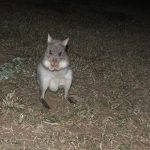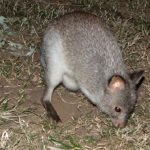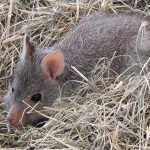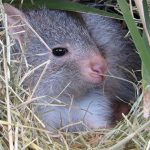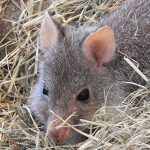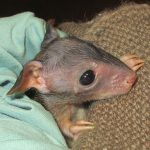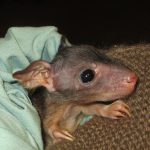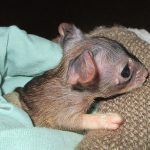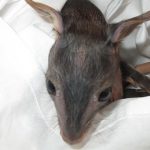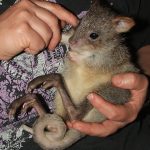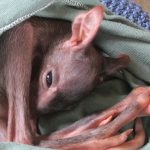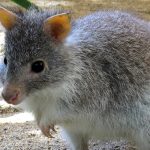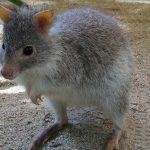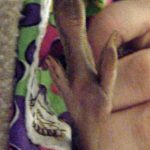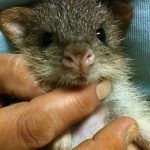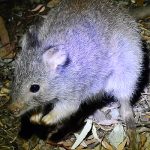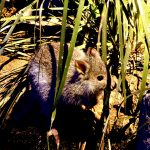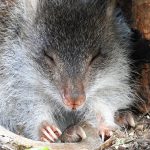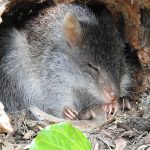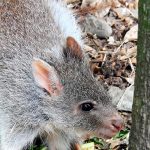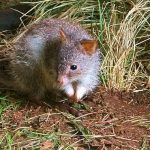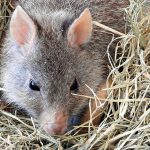RUFOUS BETTONG
Aepyprymus rufescens
Conservation status in NSW: Vulnerable
The Rufous Bettong: A Guardian of Australia’s Grassy Woodlands
Imagine the quiet hush of dawn in an open eucalypt forest. Among the dew-laden tussocks, a small, russet-furred creature stirs. This is the Rufous Bettong, a gentle and elusive member of the potoroid family. With their soft, earthy colours and delicate features, Rufous Bettongs play a vital, though often overlooked, role in maintaining the health of Australia’s landscapes.
Portrait of the Rufous Bettong
Physical Characteristics
- Size: Head and body length about 38 cm; the tail matches the body length.
- Weight: Adults range from 1 to 3.5 kg.
- Appearance: Their fur varies from dark rufous to silver grey on the back, with a creamy underside. A hairy muzzle and short ears add to their distinctive appearance.
- Adaptations: Long, strong nails are perfect for digging, while their prehensile tail helps them carry nesting material.
Sensory Experience
Picture running your hand over their soft, dense fur—cool and slightly oily from the night’s dew. The scent of cut grass lingers around their nests, mingled with the earthy aroma of upturned soil and fungi, a reminder of their close relationship with the land.
Daily Life and Behaviour
Nesting and Habitat
- Shelter: During daylight, Rufous Bettongs sleep in conical grass nests tucked into shallow hollows at the base of grass tussocks or under fallen logs.
- Habitat: They favour open forests with dense grass, often sharing these habitats with Eastern Grey Kangaroos.
Social Structure
- Solitary Nature: Except for mothers with young, they typically nest alone.
- Nesting Strategy: By building multiple nests, they can avoid predators and adapt to their environment.
Diet and Ecological Role
Foraging Habits
- Primary Diet: Roots, tubers, herbs, grasses (like Blady Grass and Poa species), fungi, and occasional insects.
- Special Relationship with Fungi:
- They consume underground truffles, which are a type of ectomycorrhizal fungi.
- These fungi form beneficial partnerships with tree roots, helping trees absorb minerals.
- By eating truffles and dispersing spores in their dung, bettongs help forests thrive—a natural cycle of nourishment and renewal.
Ecosystem Engineers
The Rufous Bettong acts as a keystone species, shaping its environment by:
- Aerating soils through digging.
- Dispersing fungal spores that support plant health.
- Encouraging plant diversity by creating microhabitats.
Life Cycle
- Reproduction: Males mature at 12 months; females at 10 months.
- Pouch Life: Joeys stay in the pouch for about 4 months, but remain close to their mother until 9 months old.
- Breeding: Females can raise two young per year, supporting population stability when conditions are right.
Threats and Conservation Challenges
Historical and Current Threats
- Habitat Loss: Clearing for agriculture has removed much of their natural range.
- Introduced Predators: Foxes, feral cats, dogs, rabbits, and hares have all contributed to their decline.
- Extinction: Two out of ten potoroid species are already extinct, highlighting the urgency of conservation.
Helping the Rufous Bettong: Conservation Strategies
| Threat | Solution | Impact |
|---|---|---|
| Habitat Loss | Protect and restore habitats | Secure food, shelter, and breeding sites |
| Introduced predators | Predator control (trapping, baiting) | Reduce predation pressure |
| Fire management | Maintain natural fire regimes | Preserve habitat structure |
| Low awareness | Public education and outreach | Foster community support |
| Genetic diversity | Captive breeding and reintroduction | Strengthen wild populations |
| Fragmented efforts | Collaboration among all stakeholders | Comprehensive, effective action |
Conservation Actions
- Habitat Protection: Secure and manage existing natural habitats.
- Habitat Restoration: Reforest cleared land and promote sustainable land use.
- Predator Control: Reduce numbers of invasive species threatening bettongs.
- Fire Management: Use planned burns to mimic natural fire cycles.
- Public Awareness: Educate communities on the ecological value of bettongs.
- Captive Breeding: Support genetic diversity and potential reintroduction.
- Collaboration: Foster partnerships across government, communities, and scientists.
Emotional Connection and Call to Action
As you picture the Rufous Bettong quietly foraging under silver moonlight, consider their vital, hidden role in Australia’s wild places. Their story is one of resilience and symbiosis—an ancient partnership with the land that benefits countless other creatures, including us.
By supporting the protection and restoration of their habitats, reducing the threat of invasive predators, and spreading awareness about their importance, we not only safeguard the Rufous Bettong but also the intricate web of life they sustain.
Every effort to protect this humble ecosystem engineer is a step toward a healthier, more balanced Australia.
Photo Gallery
Sharon:Sometimes you just get lucky when out exploring Australia’s bushland. This ‘Close Encounter’ was with the secretive Rufous Bettongs in the Savannah lands of North Queensland. Just sitting watching the moon one night we heard a tiny noise beside our camp. To my amazement it was a couple of Bettongs busily searching for insects amongst the leaf litter. What a joy we had watching them over the following half an hour before they disappeared back into the bush

